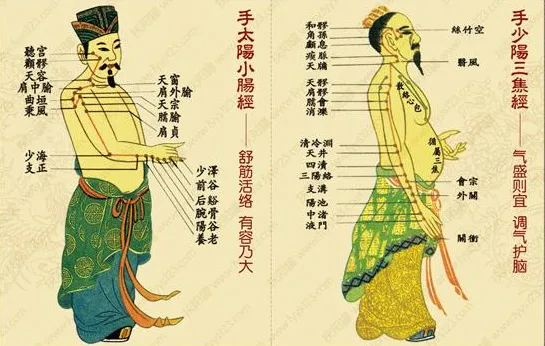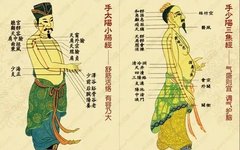Changyang Traditional Medicine Academy

01
What Are Acupoints?
Acupoints (穴位, xué wèi), scientifically known as (腧, shù), are special locations where the organs and meridians connect and where Qi and blood flow in and out. They are the primary sites for therapies such as acupuncture and tuina (Chinese therapeutic massage). These points are often located where nerve endings are dense or where thicker nerve fibers pass through. They are also referred to as孔穴 (kǒng xué),穴 (xué), and穴道 (xué dào).
Acupoints are not isolated points on the body surface; rather, they are special locations that are closely connected to deeper tissues and organs, facilitating mutual communication.
“Communication” is bidirectional.It reflects pain from the inside out; it receives stimulation from the outside in, preventing and treating diseases. In this sense, acupoints are both reaction points for diseases and stimulation points for treatment.
02
Methods for Locating Acupoints on the Human Body
Each acupoint on the human body has its own specific location. The accuracy of acupoint localization can directly affect treatment outcomes. Common methods for locating acupoints in modern clinical practice include the bone measurement method, surface landmark method, and finger measurement method.
■ Bone Measurement Method
This method divides various parts of the body into several equal segments for acupoint localization, with each segment representing one inch.
For example, the Zusanli (足三里) point is located 3 inches below the outer knee, while the Shangjuxu (上巨虚) point is located 6 inches below the outer knee. This can be determined by dividing the line from the outer knee to the midpoint of the outer ankle into 16 equal parts.
Since it is primarily measured using bones, it is called the bone measurement method.
■ Surface Landmark Method
This method uses the body’s features such as facial features, hair, nails, nipples, navel, joints, and muscle protrusions as landmarks to determine the location of acupoints.
For example, the Yintang (印堂) point is located between the eyebrows, and the Shanzhong (膻中) point is at the midpoint between the breasts.
■ Finger Measurement Method
This method uses fingers or specific parts of the fingers to measure the location of acupoints.
For instance, the distance between the two horizontal lines at the middle section of the middle finger (when bent) is considered 1 inch, known as the Middle Finger Measurement Method (中指同身寸法). The distance between the two horizontal lines at the thumb joint is also considered 1 inch, known as the Thumb Measurement Method (拇指同身寸法). The distance between the index, middle, ring, and little fingers held together is considered 3 inches, known as the One Husband Method (一夫法).
Note: “One finger width” refers to the width of the thickest part of the thumb; “Two finger widths” refers to the width measured at the second joint of the index and middle fingers held side by side. The size and width of fingers can vary greatly depending on age, physique, and gender. When using this method to locate acupoints mentioned in diagrams, please use the patient’s finger width for reference.
03
Tips for Finding Acupoints
Acupoints are places where reactions occur. When there is an abnormality in the body, various reactions will appear at the acupoints.
These reactions include:
1. Pain upon pressure (tenderness);
2. Hard lumps (nodules) upon touch;
3. Skin sensitivity (itchiness) upon slight stimulation;
4. Dark spots or discoloration (pigmentation);
5. Temperature differences in the surrounding skin (temperature changes), etc.
The presence or absence of these reactions is an important indicator of acupoint status.
04
Key Points for Acupoint Selection
In clinical practice, acupoint selection often relies on the bone measurement method, supplemented by other methods. It is also essential to consider the patient’s position and posture, and to reference surrounding areas.
The principles of acupoint selection can be summarized as follows:
1. Measure according to segments, keeping a mental note;
2. Observe surface landmarks for acupoint determination;
3. Use appropriate postures for acupoint selection;
Some acupoints should be selected while sitting, while others are better accessed in a lying position; some require straight limbs, while others need bent limbs. Clinical practice should adapt to specific situations. Additionally, simple activity markers can also be used for acupoint selection.
4. Select five acupoints but use one, select three meridians but use one
Ancient wisdom states, “Select five acupoints but use one, and select three meridians but use one correctly.” This means that when selecting a specific acupoint, one must understand the surrounding acupoints; when determining a specific meridian, one must reference the pathways of nearby meridians. Comprehensive consideration is necessary for accurate acupoint localization.
The acupoints of the entire body,the Du Meridian (督脉) and Ren Meridian (任脉) are located along the midline, making their acupoints easier to identify. Therefore, the acupoints of the Ren and Du meridians are often used as reference points for locating acupoints on either side.
However, the acupoints on the head and shoulders are more complex and require careful differentiation during selection.
When selecting acupoints on the outer side of the limbs, one should primarily observe bony landmarks such as depressions; whilewhen selecting acupoints on the inner side of the limbs, one should also pay attention to arterial pulsations and other signs.
05
The Functions of Acupoints in the Human Body
The primary physiological function of acupointsis to facilitate the flow of Qi and blood through the organs and meridians, connecting the surface of the body with the internal organs. In clinical practice, doctors utilize the functional characteristics of acupoints for diagnosis and treatment of diseases.
When diseases occur, corresponding acupoints often exhibittenderness, soreness, numbness, nodules, swelling, discoloration, papules, desquamation, and depression, among other reactions. The different pathological responses observed at acupoints are the result of imbalances in Qi and blood within the organs and meridians during the disease process.
Therefore, utilizing the pathological response characteristics of acupoints can aid in diagnosing diseases. Common methods include:
1. Palpation Diagnosis Method
For example, if tenderness is present at Zusanli (足三里) on the left side, it may indicate a stomach issue, while tenderness on the right side may indicate a duodenal issue.
2. Observation Diagnosis Method
For instance, observing the sublingual veins (Jinjin and Yuye) can provide insights into internal blood stasis.
3. Auricular Observation Method
Examining changes in the skin of the ear, such as discoloration, deformation, or degeneration.
4. Instrument Measurement Method
This often utilizes the electrical conductivity characteristics of acupoints for disease diagnosis.
By stimulating corresponding acupoints through acupuncture, tuina, and other treatment methods, one canunblock the meridians, invigorate Qi, and adjust the flow of Qi and blood, achieving the goal of strengthening the body and expelling pathogens.
The therapeutic effects of stimulating acupointsare effective not only for local organ and tissue issues, but also for conditions affecting distant organs and tissues along the pathways of the corresponding meridians.
This reflects the local and distant therapeutic effects of acupoints. The distant therapeutic effects of acupoints are particularly prominent among the fourteen meridians. Additionally, certain acupoints have special therapeutic effects and can specifically treat certain conditions, such as the Zhiyin (至阴) point, which can correct fetal position and treat malpresentation.
Disclaimer: The content of this article, if it involves formulas or therapies, is for reference only and should not be used indiscriminately. The article and images are sourced from the internet; if there is any infringement, please contact us for removal.
Share this with those who care.
The more people see it, the more health we can spread!
Today's Recommendations

